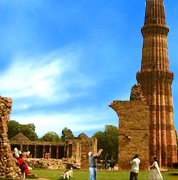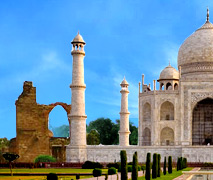Many people believe that corresponding to this
sparkling white Taj, Shah Jehan had planned to build another Taj Mahal
in black marble, which was to be his own tomb on the opposite bank of
the River Yamuna and connect the two by a bridge. This legend further
got wings in form of the records of a contemporary traveler who noted
that Shah Jehan began to build his own tomb on the other side of the
river but because of the war with his sons, his plan was interrupted.
Later, Aurangzeb was unwilling to complete it. These people also cite
irregular positioning of the cenotaph of Shah Jehan as compared to the
central positioning of that of Mumtaz Mahal as a proof to their theory.
They further attach the Mehtab Burj opposite the Taj Mahal and its
adjoining wall as actually the foundations and remnants of the abandoned
plan.
However, most of these theories are only rumors as there is no logical
base to substantiate them. While there are records that prove that the
Mehtab Burj and the adjoining wall were just the part of the enclosing
wall and the remains of a garden laid by the first Mughal emperor Babur
much before Taj Mahal was constructed, the irregular positioning of Shah
Jehan's cenotaph to that of Mumtaz Mahal's, is not of much significance
either as this pattern can also be seen at the tomb of Itmad-ud-Daulah
and was only done to conform to the Islamic law stating that bodies of
the departed should be buried with their head towards Mecca and legs
towards south and also that the husband should always be placed on the
right hand side of his wife. So all these assumptions are baseless and
are even scoffed at by some other historians.
Many people believe that corresponding to this sparkling white Taj, Shah Jehan had planned to build another Taj Mahal in black marble
Golden Triangle India » Taj Mahal » Story of Black Taj Mahal












